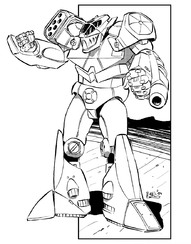Werewolf (BattleMech)
Sarna News

- HEXTECH Review - Wave 3 Brings More Urban Options To Your Battlefield
- Your BattleTech News Round-Up For March, 2024
- Crashing 'Mechs With Jennifer Brozek, Author Of The Rogue Academy Trilogy
- Getting The Word Out With Rem Alternis, Catalyst Community & Marketing Director
- Bad 'Mechs - Yeoman
- Read more →

| |
| Werewolf | |
|---|---|
| Production information | |
| Manufacturer | O'Neil BattleMechs of Solaris |
| Production Year | 3060[1] |
| Model | WER-LF-005 |
| Class | Medium |
| Cost | 5,407,827 C-bills |
| Technical specifications | |
| Mass | 40 tons |
| Chassis | O'Neil Model II |
| Armor | Starshield/Null Signature System |
| Engine | Nissan 200 XL |
| Speed | 86 km/h |
| Jump Jets | Rawlings 75 |
| Armament |
|
| BV (1.0) | 935 |
| BV (2.0) | 1,082[2] |
Contents
Description
A Solaris VII BattleMech, the Werewolf was introduced in 3056. Designed as an ambush 'Mech, the Werewolf was a huge hit with pilots who favored the dense jungle or industrial scrapyard arenas because it mounted a Null Signature System. This system allows a skilled pilot to hide in plain sight, striking an opponent quickly and often fatally.
The eight tons of armor provide decent protection against most foes and the Werewolf's speed allows it to evade anyone it can't outfight. The Werewolf mounts twin Jump Jets, which provide it with a limited jump capability. This capability is most frequently used by arena MechWarriors to launch a Death From Above attack, but it is also useful when evading a foe.
Weapons and Equipment
The Werewolf's main armament is its Sutel Precision Line Large X-Pulse Laser, which is backed up by a Holly Streak SRM-6 launcher, and a pair of Poland Main Model C Magshots. All of these close-in weapons were chosen because they encourage the pilot to attack from closer ranges.
Variants
- WER-LF-004
- This older Werewolf lacks the Null Signature System of the WER-LF-005. Instead of the Large X-Pulse Laser it carries a Large Pulse Laser, a standard SRM-6 launcher in place of the Streak SRM-6, and a pair of Small Pulse Lasers in place of the WER-LF-005's Magshots. To make up for this, it can jump twice as far and is protected by an additional half-ton of armor. BV (2.0)= 802[3]
Notable pilots
- Alan "Wolfman" Penkerhman, A notable warrior of the Banshees Stables on Solaris.[4]
References
- ↑ MUL online date for the Werewolf (BattleMech)
- ↑ Record Sheets: 3055 Upgrades Unabridged, p. 239
- ↑ Record Sheets: 3055 Upgrades Unabridged, p. 238
- ↑ Technical Readout: 3055 Upgrade, p. 142

